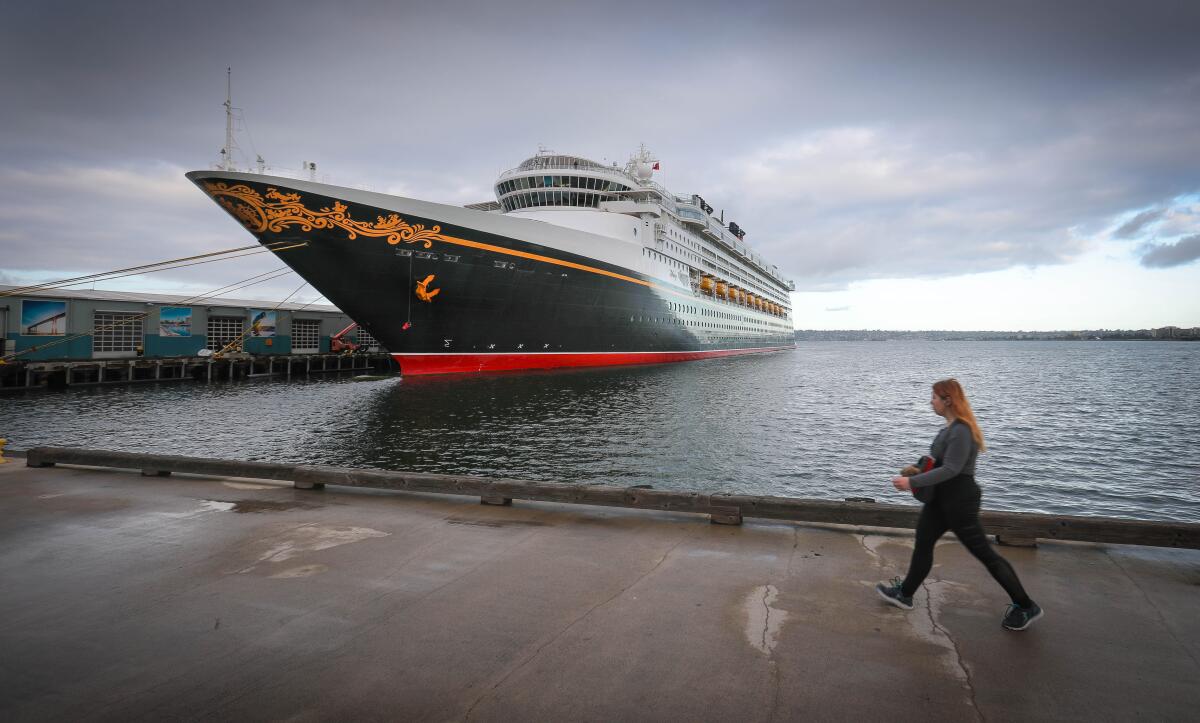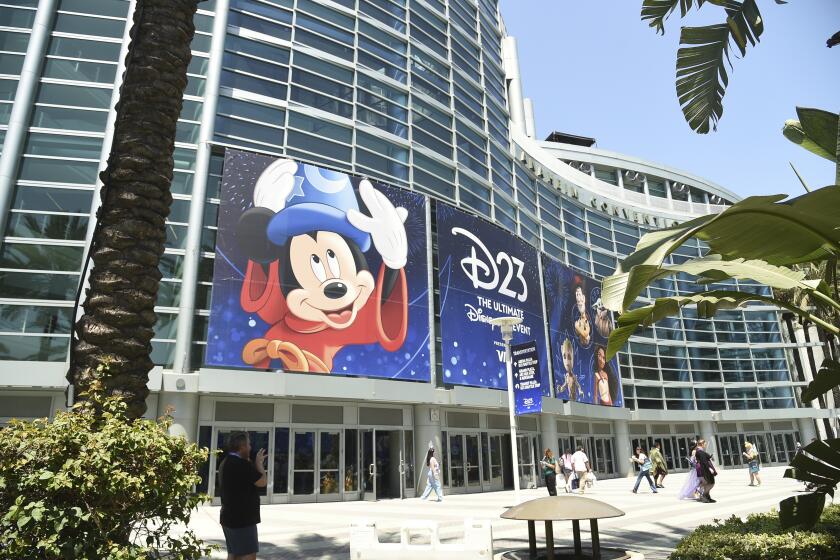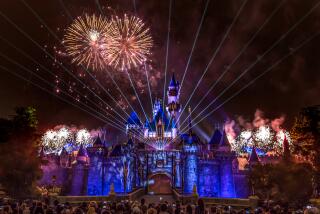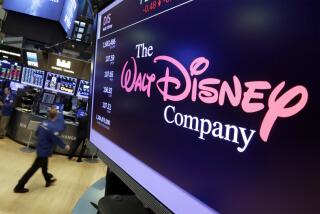Disney is doubling its fleet of cruise ships. What that says about the company’s strategy

- Share via
When Cal State Fullerton professor Andi Stein set sail on her first Disney Cruise trip to the Bahamas for research more than a decade ago, she was on the fence about the idea. Unsure what it would be like voyaging with so many youngsters, she booked a short four-day journey.
By the time she came back, Stein was hooked. She booked another Disney cruise to the Mexican Riviera aboard the Disney Wonder with her mom about two months later. Her fandom has persisted since then. Last year, she took a seven-day cruise on the Disney Fantasy to the Caribbean.
“Disney really understands entertainment, and that carries through onto their cruise ships,” said Stein, who wrote a book about the Disney brand. “But they add the luxury experience that a cruise can provide that you’re not necessarily going to get in the theme parks.”
Walt Disney Co. is banking on winning over more vacationers like Stein, and it’s spending big bucks to do so.
Disney plans to expand its five-ship fleet to eight ships by next year. By 2031, the company will have 13 ships worldwide, Disney experiences chairman Josh D’Amaro said in August at the D23 fan event in Anaheim.
After a year of boardroom drama and box office disappointment, Disney seems to be rounding a corner. Fans at its biennial D23 convention feel the difference.
“Expanding our fleet gives more people, in more parts of the world, the opportunity to experience a vacation at sea like only Disney can provide,” he said at the event.
The fact that the company is investing heavily in the cruise line indicates that it sees future opportunity there, said Brent Penter, associate analyst at investment banking firm Raymond James. He expects Disney’s capital expenditures to rise 27% to $7 billion companywide next year, an increase driven primarily by final payments for the new ships.
Penter said the ships are “billion-dollar investments,” but they’re worth the expense.
“It’s a business that’s still small enough that demand really outstrips supply,” he said. “We think they’re doing the smart thing by investing in this business so that they can serve a lot more of that demand.”
Though still a relatively small business, the Disney Cruise Line is becoming an increasingly important part of the company’s financial picture, and is currently a bright spot as the firm’s parks segment begins seeing signs of softening demand.
The Burbank media and entertainment giant doesn’t break out financial results for the cruise line, but Raymond James estimates it brings in about $3 billion a year, comprising 3% of Disney’s overall 2023 revenue.
Disney in August said the cruise line, among other segments, had “improved results” compared to the prior year for Disney’s fiscal third quarter while its overall “experiences” division reported a 3% decrease in operating income. (That division includes the theme parks, merchandise and travel and leisure offerings such as the Aulani resort and spa in Hawaii.)
Disney is willing to take a short-term financial hit from its investment in an expanded fleet. The company warned analysts during its third-quarter earnings call that its fourth-quarter results would reflect pre-launch costs for two of its new ships.
“The business, even prior to COVID, ... continues to generate double-digit return on investment for our shareholders,” said Thomas Mazloum, president of Disney’s New Experiences Portfolio and Disney Signature Experiences, which includes the cruise line. “With our expansions, we certainly expect similar, attractive returns from our future ships.”
The cruise industry was growing before the pandemic, but took a big plunge once the virus spread. Demand for such tourist voyages have since rebounded. Last year’s global passenger volume was up 6.8% to 31.7 million, compared to 29.7 million in 2019, according to a May report from the Cruise Lines International Assn. trade group. By 2027, the number of cruise passengers is expected to reach nearly 40 million.
“It’s part of the total pent-up demand for tourism coming out of COVID,” said Andrew Coggins, Jr., a cruise industry analyst who teaches at Pace University’s Lubin School of Business. “The industry is very bullish about what’s coming up ahead.”
That’s why many cruise lines, ranging from major players such as Royal Caribbean and Carnival Corp., which is the biggest cruise parent company, to smaller operators like Disney, are building new ships and expanding their business.
For Disney, that’s meant adding new routes, particularly in the Asia market, and new onboard attractions. The company now represents about 5% of the total Caribbean market and 2.5% of the worldwide market, Mazloum said.
He called the cruise line a “significant contributor” to the experiences division, with a “long runway left.”
After launching in 1998, the Disney cruise line has capitalized on the company’s virtuous cycle strategy of having parks and experiences fuel interest in its movies and TV shows, and vice versa.
Disney cruises offer themed experiences at sea that focus on characters from popular franchises such as Pixar, Star Wars and Marvel. Guests interact with Disney characters aboard, hear talks from animators, eat at themed restaurants, and watch Disney stage productions.
Disney views the cruise line as a “movable asset” that serves as an ambassador of the company’s brand, Mazloum said. The ship allows guests from all areas of the U.S. and world to interact with Disney characters outside of the parks and combines that experience with travel destinations, he said.
“This growing fleet ... truly enables us to bring that experience — that Disney experience, that vacation experience — to new audiences and new places all around the world,” Mazloum said.
While some have groused that Disney theme park prices have gotten too expensive, the same hasn’t been said of the cruise line, according to a survey conducted this summer by Raymond James. A recent two-day cruise aboard the Disney Magic from Auckland, New Zealand, for one person started at $728.
Only 31% of respondents said the cruises were overpriced, despite Disney cruises being about two to three times more expensive than that of competitors, according to the survey, which interviewed 20 Disney “superfans,” annual passholders, travel agents and local business owners. Though comments acknowledged that the cruises were expensive, respondents felt it was worth it because of the “all-in” price.
David Hahn of Dothan, Ala., has been on many cruises and said he was willing to pay the high price for Disney’s quality of service. He tells family members to choose a Disney cruise over a visit to the theme parks because it’ll be enjoyable with less stress.
For years, Hahn channeled his love for all things Disney through the company’s sprawling parks, visiting Walt Disney World hundreds of times. But as the magic wore off in recent years because of massive crowds and long lines, this 37-year-old waste hauling operations manager turned to cruises instead. (He also worked at Disney’s resorts for several years until 2020.)
He’s taken three Disney cruise trips so far, sailing to the Bahamas aboard Disney ships and in 2019 proposing to his now-wife, April, aboard the Disney Dream. The crew helped him get his room ready for the proposal, with rose petals, champagne and towels shaped into hearts and animals.
“When you go on the ship, you’re kind of secluded, you’re surrounded by all the Disney, the atmosphere, you get that feeling of great hospitality,” said Hahn. “You’re going to pay for it, of course, ... but you’re going to get what you pay for.”
More to Read
Inside the business of entertainment
The Wide Shot brings you news, analysis and insights on everything from streaming wars to production — and what it all means for the future.
You may occasionally receive promotional content from the Los Angeles Times.












